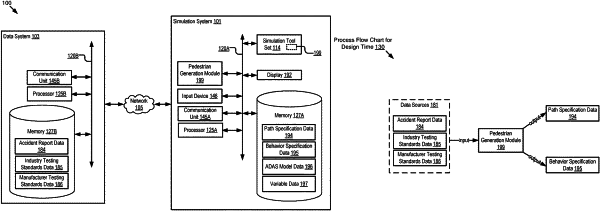| CPC G08G 1/166 (2013.01) [B60W 40/00 (2013.01); G01M 17/007 (2013.01); G08G 1/005 (2013.01); G08G 1/012 (2013.01); G08G 1/0962 (2013.01)] | 20 Claims |

|
1. A method comprising:
automatically generating, for a virtualized testing of a virtual vehicle that does not exist in a real-world, a set of virtual pedestrians based on a path specification, a behavior specification, and variable data that describes one or more variables that are inputted by a user including a minimum waiting time and a maximum waiting time for beginning to cross an intersection after a traffic signal indicates that it is legal to cross the intersection, wherein each virtual pedestrian in the set of virtual pedestrians is associated with a unique combination of the path specification, the behavior specification, and the variable data;
executing a digital simulation that includes the set of virtual pedestrians crossing the intersection and the virtual vehicle responding to the set of virtual pedestrians crossing the intersection, wherein the digital simulation is operable to measure a performance of a virtual Advanced Driver Assistance System (virtual ADAS system) included in the virtual vehicle to protect the set of virtual pedestrians when responding to the set of virtual pedestrians crossing the intersection;
determining that the virtual ADAS system did not perform in compliance with a design specification; and
determining a recommendation for modifying a design of the virtual ADAS system.
|